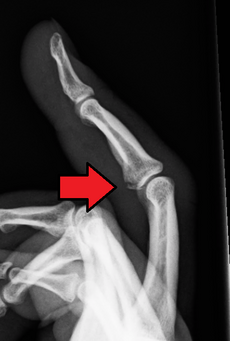Avulsion fracture
| Avulsion fracture | |
|---|---|
| Classification and external resources | |

Avulsion fracture of the proximal metacarpal on the volar side
|
An avulsion fracture is a bone fracture which occurs when a fragment of bone tears away from the main mass of bone as a result of physical trauma. This can occur at the ligament due to the application forces external to the body (such as a fall or pull) or at the tendon due to a muscular contraction that is stronger than the forces holding the bone together. Generally muscular avulsion is prevented due to the neurological limitations placed on muscle contractions. Highly trained athletes can overcome this neurological inhibition of strength and produce a much greater force output capable of breaking or avulsing a bone.
If the fracture is small, it is usually sufficient to treat with rest and support bandage, but in more severe cases, surgery may be required. Ice may be used to relieve swelling.
For displaced avulsion fractures, they are best managed by either open reduction and internal fixation or closed reduction and pinning. Open reduction (using surgical incision) and internal fixation is used when pins, screws, or similar hardware is needed to fix the bone fragment.
Traumatic complete displacement of a tooth from its socket in alveolar bone. It is a serious dental emergency in which prompt management (within 20–40 minutes of injury) affects the prognosis of the tooth.
The tuberosity avulsion fracture (also known as pseudo-Jones fracture or dancer's fracture is a common fracture of the fifth metatarsal (the bone on the outside edge of the foot extending to the little toe). This fracture is likely caused by the lateral band of the plantar aponeurosis (tendon). Most of these fractures are treated with a hard-soled shoe or walking cast. This is needed until the pain goes away and then the patient can return to normal activities. Healing is usually completed within eight weeks.
...
Wikipedia
